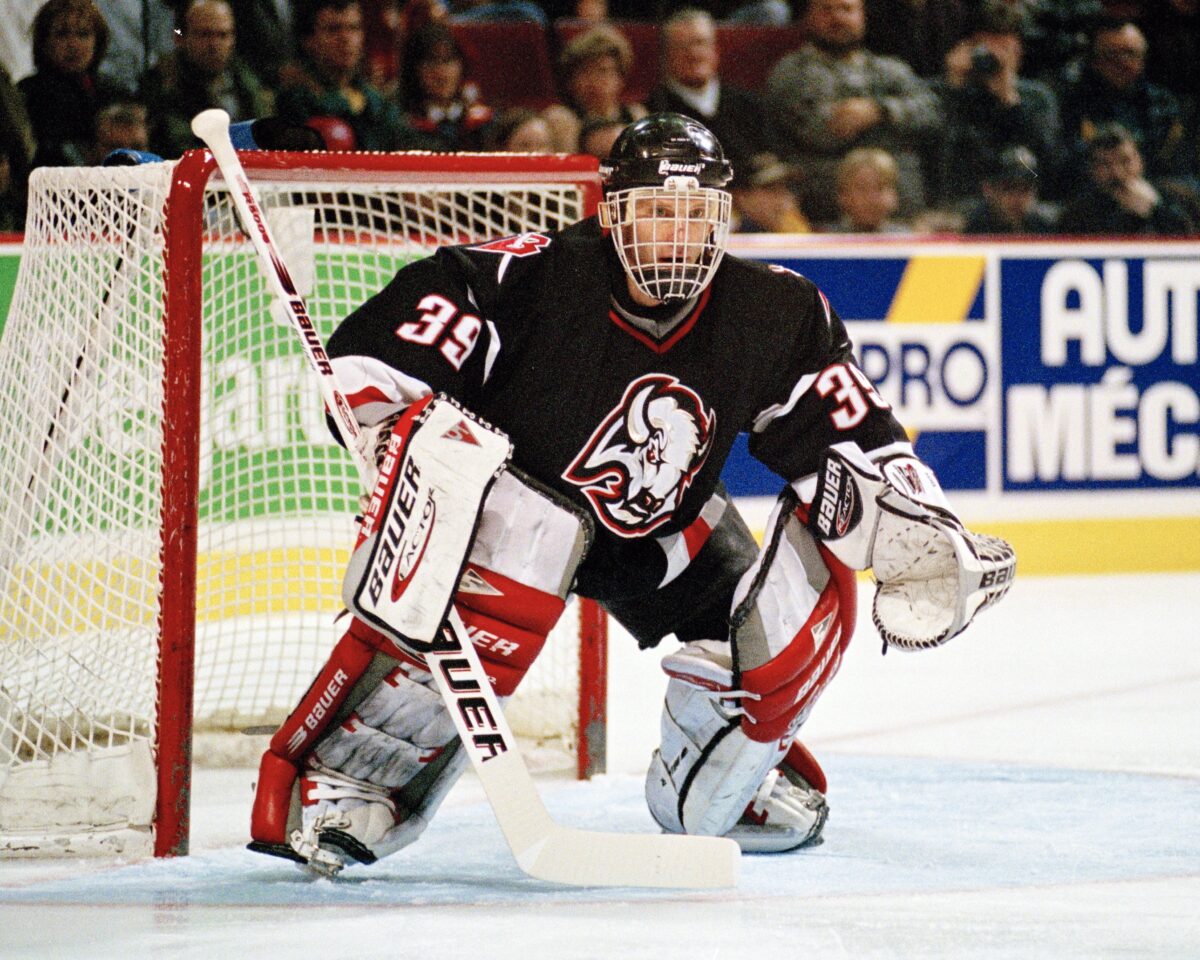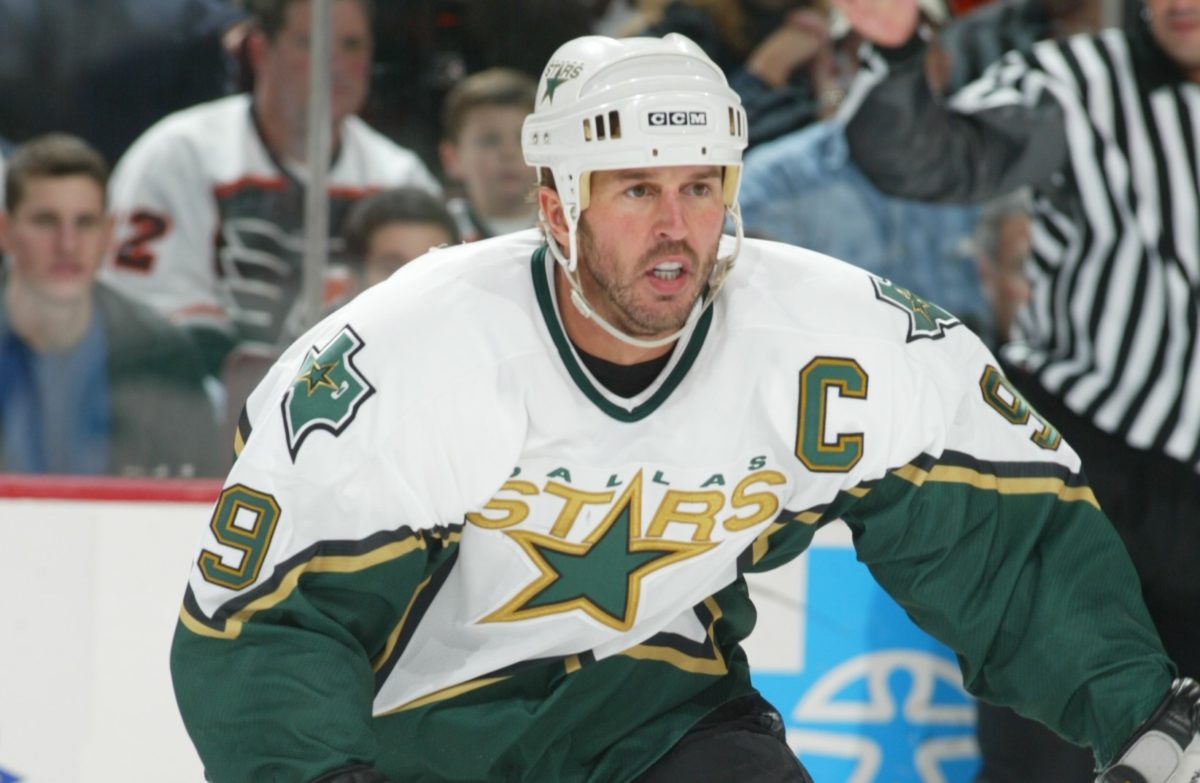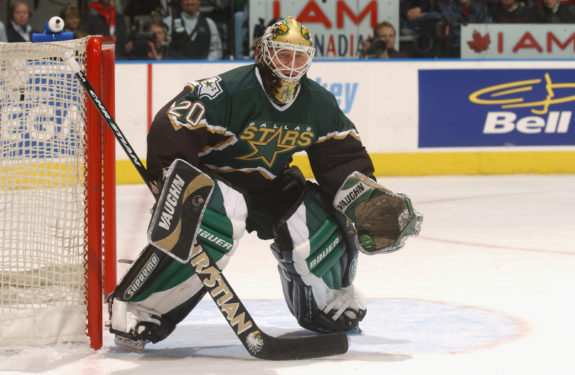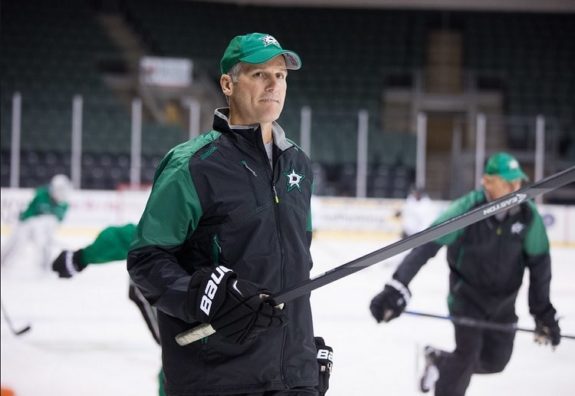Sports fans in Buffalo, New York suffered two crushing, devastating championship defeats in the 1990s, both of which can be summed up in two words. For the National Football League’s Buffalo Bills, it was “Wide Right”, a term that has become synonymous with failure to come through in the clutch. But for the NHL’s Buffalo Sabres, it’s “No Goal”, which has become synonymous with questionable rulings by the officials.
As we continue to take a look at the toughest and most notable defeats in Buffalo Sabres history, let’s dive into the sea of controversy that the finish to the 1999 Stanley Cup Final created and why it’s still a point of contention 23 years later in both Buffalo and the hockey world.
1998-99 Was the Strangest Season the Sabres Ever Had
The Sabres tore up the first half of the 1998-99 season and sat in first place in the Eastern Conference at the midway point, but plummeted in the second half and just barely qualified for the playoffs, entering as the seventh seed. To be fair, the team saw quite a few significant injuries, including a lower-body ailment that hampered Dominik Hasek all season and kept him out for 12 games.

The struggles gave Buffalo the impetus to improve its roster, and then-general manager Darcy Regier actually answered the bell. Future captain Stu Barnes was acquired from the Pittsburgh Penguins in exchange for the disgruntled Matthew Barnaby. Joe Juneau, who scored the overtime winner to eliminate the Sabres in Game 6 of the previous season’s Eastern Conference Final, was also acquired from the Washington Capitals.
Thanks in part to the moves, the Sabres’ offense improved considerably that season and proved that the team was more than a bunch of bruisers carried by the best goaltender on planet Earth. Miroslav Satan scored 40 goals and captain Michael Peca added 27 while Michal Grosek, Curtis Brown and Dixon Ward all contributed 40 or more points. It took some of the pressure off Hasek and allowed him to continue his otherworldly play and win yet another Vezina Trophy (his fifth in six seasons).
Though they fell hard in the standings, the Sabres were a better team than their seeding showed in the 1999 Stanley Cup Playoffs and became “giant killers” as a result. Despite missing Satan for a majority of the run due to a foot injury, they took down three of their Northeast Division opponents in the Ottawa Senators (4-0), Boston Bruins (4-2) and Toronto Maple Leafs (4-1). The Eastern Conference Final was especially intriguing as it was the first time the Sabres and Maple Leafs had met in the postseason, creating a frenzy of excitement in the Golden Horseshoe region.
Though it would have been difficult to imagine at the end of the regular season, Buffalo was on to its first Stanley Cup Final in 24 years. But their toughest task yet lay ahead of them.
Sabres vs Stars Was David vs Goliath Matchup
Awaiting the Sabres in the final Stanley Cup Final of the millennium were the Dallas Stars, the regular season champion that finished 23 points ahead of them in the standings. Though the teams shared the commonality of not having a championship title, their identities could not have been more split. The 1998-99 Stars were a super-team, a high-flying offensive juggernaut with a veritable battalion of firepower that featured six future Hall of Famers (Mike Modano, Brett Hull, Joe Nieuwendyk, Guy Carbonneau, Sergei Zubov and Ed Belfour). They wracked up 236 goals that season and allowed an NHL-low 168, running away with the Presidents’ Trophy and finishing nine points ahead of the runner-up New Jersey Devils.

In stark contrast, the Sabres were a group of punishing, ground and pound battlers that forged victories through tenacity and toughness. While Satan, Peca and Ward handled the scoring duties, the likes of Rob Ray, Wayne Primeau, Randy Cunneyworth and Vaclav Varada added a gritty physical edge that consistently made the team one of the toughest to play against. And though they scored only 207 goals that year (third least among teams that made the postseason), they allowed only 175 goals against (second fewest behind Dallas) thanks to Hasek’s brilliance and strong team defensive play.
Though the media didn’t see it at the time, the pieces were in place for a memorable series, and it proved to be just that.
The Belfour-Hasek Dichotomy
A fascinating aspect of the series that doesn’t get talked about nearly enough is the connection between the starting goaltenders. Ed Belfour and Dominik Hasek (both enshrined in Toronto) were already quite familiar with each other before the puck dropped in Game 1.
Related: Best NHL Goalies of the 1990s
Before coming to the Stars, Belfour made his name with the Chicago Blackhawks, winning both the Calder and Vezina Trophies in 1991. And it was that success that led to his opponent at the other end of the ice being where he was. Hasek was also a rookie for the Blackhawks in 1990-91, but Belfour’s dominance relegated him to the bench and he saw very limited time. However, his big break came in Game 4 of the 1992 Stanley Cup Final when he relieved Belfour and helped the Blackhawks rally to force overtime with a dazzling performance.

Though the Penguins eventually won the game to sweep the series, the seeds of what would become known as “The Dominator” had been planted. The Sabres already knew that the Czech goaltender was something special and had attempted to trade for him earlier that season and finally acquired him in the summer of 1992 in what became one of the most lopsided trades in NHL history (Chicago received goaltender Stephane Beauregard, who never played a game for the team, and a draft pick that turned out to be Eric Daze, who was plagued by injuries throughout his career).
While Hasek ironically went on to have a better career, Belfour continued to shine and came to the Stars after spending half a season with the San Jose Sharks. Had “The Eagle” not gotten off to such a strong start, perhaps it would have been Hasek who went on to become the guy in Chicago and he would have wound up elsewhere. Whether it was serendipity or just an amazing coincidence, the goaltenders’ shared history gave added intrigue to the NHL’s last championship of the 20th century, and they took center stage.
Buffalo Was Not Star-Struck
As one could expect, the Stars were heavily favored to win the series and expected to make easy work of it. However, the Sabres were not intimidated and proved it immediately in Game 1, stunning the Stars and the crowd alike at Dallas’ Reunion Arena in overtime when Jason Woolley fired what Rick Jeanneret called “the shot heard ’round the world”. The Stars quickly seized the momentum back and took the next two games for a 2-1 series lead before the Sabres evened it in Game 4.
[embedyt] https://www.youtube.com/watch?v=uEAXm_FnanM[/embedyt]Hasek and Belfour were in top form all series long. All but two games were decided by one goal as both netminders stood on their heads night in and night out to put their names in the Conn Smythe Trophy conversation. In Game 5 in Dallas, Belfour posted a 2-0 shutout (albeit on only 23 shots) to put his team within a victory of its first-ever Stanley Cup.
The series shifted back to Buffalo with the Sabres against the wall for the first time that postseason and in desperate need of an edge. Game 6 of the 1999 Stanley Cup Final on Tuesday, June 19 became one of the most legendary contests in NHL history, but not entirely for great reasons.
Marine Midland Arena Marathon
After Jere Lehtinen put the Stars on the board in the first period, the Sabres finally broke through for the first time since Game 4 when Stu Barnes beat Belfour late in the second. That would be the last goal scored for more than an hour of game time, as the third period and first and second overtimes all ended in draws. As the evening turned into morning, the crowd at then-Marine Midland Arena hung on the edge of its collective seat as the action remained unbearably tense.
Both teams missed numerous chances as both goaltenders refused to yield. Buffalo’s James Patrick came agonizingly close to sending his team to a seventh game when his point shot in the second overtime went off the crossbar. It was 1:30 on Wednesday morning as the third overtime approached its conclusion, with a victor still yet to be decided.

Then, with the contest on the cusp of doubling its original length, Brett Hull picked up a pass at the front of the Buffalo net and got one past Hasek for the first time in four periods to end the epic struggle and send the Stanley Cup to Texas for the first time ever. The Stars piled onto the ice to celebrate, while the Sabres could only sit and await the handshake line. Despite Belfour’s brilliance, a surprise came when Joe Nieuwendyk was awarded the Conn Smythe Trophy as MVP of the postseason.
But then, while the Stars were taking the customary lap around the ice with Lord Stanley’s chalice, Darcy Regier and head coach Lindy Ruff emerged from the Sabres’ locker room demanding the game to be restarted. Though it hadn’t been noticed immediately, an issue with the deciding goal was evident, and there was validity to the Sabres’ argument (from “‘No Goal’ was yet another agonizing result for Buffalo fans”, The Democrat & Chronicle, 6/5/2020).
The Foot in the Crease & the Phantom Memo
Replays showed that Hull’s foot had been in the goal crease before the puck was shot. In today’s NHL, nobody would think twice of it, but at the time, it was a hot-button issue.
Years earlier, the NHL introduced a new rule in order to give goaltenders more protection. The size of the crease in front of the net was expanded and it became illegal for a skater to be in the crease without possession of the puck. Frankly, it was a stupid rule and almost universally disliked as countless goals were overturned despite the goaltender not being obstructed. Nevertheless, the NHL stuck with the change and implemented it numerous times during the 1998-99 season.
As if the higher forces intended it, this was a situation that the rule was designed for, but it was not enforced. Despite what appeared to be a clear violation, the NHL upheld the goal and stated that since Hull had possession beforehand, he was allowed to enter the crease (despite the replay showing that he may not have had definitive possession). Both the NHL and Hull himself (unsurprisingly) continue to insist that the call was correct.
[embedyt] https://www.youtube.com/watch?v=-scUvIwosHQ[/embedyt]Frequently cited was a private memorandum the NHL released earlier that season that amended the rule to allow for players to be in the crease even if the puck wasn’t – so long as possession had been maintained. However, it’s been debated how well it was circulated inside the league, as the Sabres and many analysts seemed to have no idea of its existence. Fans over the years have criticized the NHL’s ruling as a post hoc excuse, while others have speculated that the goal would have been overturned had the Stars not already been awarded the Stanley Cup.
The Sabres refused to leave their locker room until Bryan Lewis, then-NHL Director of Officiating, came to explain the interpretation of the rule. As is common knowledge now, the team refused the reasoning they were given. Ruff famously stated “no goal” at a rally a few days later and the incident has been known in Buffalo as that ever since.
It’s a truly unfortunate situation for both teams. The Sabres lost for reasons that they may not have even been aware of and were left feeling robbed. And whether Stars fans like it or not, the team’s only championship to date will always have a cloud over it, regardless of whether one believes the goal was legal or not. It will be debated until the end of time and it continues to polarize fans to this day.
It was very bad form for the NHL either way. Though likely with good intentions, the league created a largely unpopular rule that seemed to cause far more harm than good but failed to enforce it in the biggest scenario possible. Certainly not a good look for commissioner Gary Bettman, whose reputation only got worse with time.
“No Goal” Changed Hockey Forever
Before the 1999-00 season began, the rule was erased altogether and players were allowed to stand in the goal crease as long as the goaltender was not interfered with. The decision made the NHL look even guiltier and gave further credence to the argument that the league had dropped the ball during the 1999 Cup Final.
It’s impossible to say what would have happened had the goal not stood up. Though it’s tough for me as a Sabres fan to accept this, there’s no guarantee that Buffalo would have won if it was not. The Stars could still have gone on to win Game 6, or perhaps the Sabres would have and then lost in Game 7 in Dallas. Though to be fair, the Sabres weren’t expected to stand a chance in the series yet took the Stars to just about the limit, so it could have been entirely possible.
Related: Predicting the Sabres’ Defense Pairs for the 2022-23 Season
The 1999 Stanley Cup Final was one of the best ever played and was an epic conclusion to hockey in the 20th century. Though the Stars were clearly more talented, the underdog Sabres stood tall and proved that they were not there by accident. The result was an action-packed back-and-forth series that had spectators on both sides constantly holding their breath.
Unfortunately, it will also always be overshadowed by the controversial ending and the Sabres are left wondering “what if” as a result.